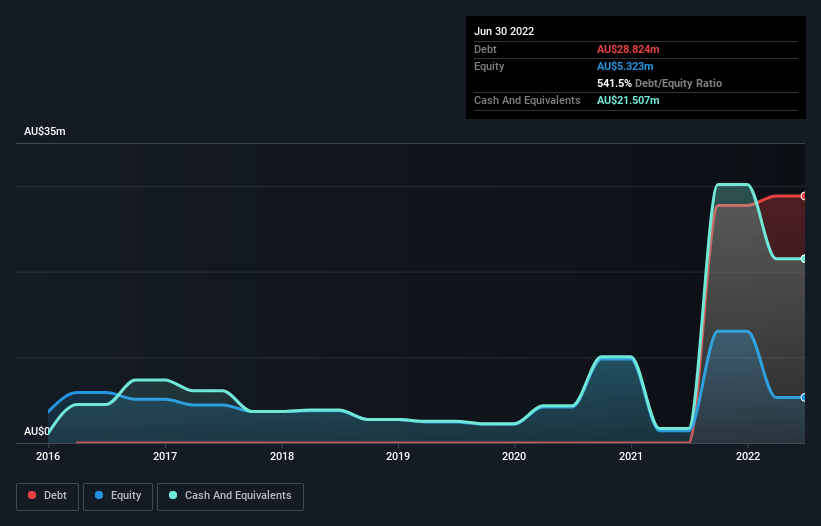- Australia
- /
- Metals and Mining
- /
- ASX:BDM
We Think Burgundy Diamond Mines (ASX:BDM) Has A Fair Chunk Of Debt
Warren Buffett famously said, 'Volatility is far from synonymous with risk.' So it seems the smart money knows that debt - which is usually involved in bankruptcies - is a very important factor, when you assess how risky a company is. Importantly, Burgundy Diamond Mines Limited (ASX:BDM) does carry debt. But should shareholders be worried about its use of debt?
When Is Debt A Problem?
Debt and other liabilities become risky for a business when it cannot easily fulfill those obligations, either with free cash flow or by raising capital at an attractive price. Ultimately, if the company can't fulfill its legal obligations to repay debt, shareholders could walk away with nothing. However, a more frequent (but still costly) occurrence is where a company must issue shares at bargain-basement prices, permanently diluting shareholders, just to shore up its balance sheet. By replacing dilution, though, debt can be an extremely good tool for businesses that need capital to invest in growth at high rates of return. When we examine debt levels, we first consider both cash and debt levels, together.
Check out the opportunities and risks within the AU Metals and Mining industry.
What Is Burgundy Diamond Mines's Net Debt?
As you can see below, at the end of June 2022, Burgundy Diamond Mines had AU$28.8m of debt, up from none a year ago. Click the image for more detail. On the flip side, it has AU$21.5m in cash leading to net debt of about AU$7.32m.

A Look At Burgundy Diamond Mines' Liabilities
Zooming in on the latest balance sheet data, we can see that Burgundy Diamond Mines had liabilities of AU$2.00m due within 12 months and liabilities of AU$29.5m due beyond that. On the other hand, it had cash of AU$21.5m and AU$204.2k worth of receivables due within a year. So it has liabilities totalling AU$9.82m more than its cash and near-term receivables, combined.
Given Burgundy Diamond Mines has a market capitalization of AU$80.5m, it's hard to believe these liabilities pose much threat. Having said that, it's clear that we should continue to monitor its balance sheet, lest it change for the worse. When analysing debt levels, the balance sheet is the obvious place to start. But you can't view debt in total isolation; since Burgundy Diamond Mines will need earnings to service that debt. So when considering debt, it's definitely worth looking at the earnings trend. Click here for an interactive snapshot.
Since Burgundy Diamond Mines has no significant operating revenue, shareholders probably hope it will develop a valuable new mine before too long.
Caveat Emptor
Over the last twelve months Burgundy Diamond Mines produced an earnings before interest and tax (EBIT) loss. Its EBIT loss was a whopping AU$16m. When we look at that and recall the liabilities on its balance sheet, relative to cash, it seems unwise to us for the company to have any debt. So we think its balance sheet is a little strained, though not beyond repair. Another cause for caution is that is bled AU$29m in negative free cash flow over the last twelve months. So suffice it to say we consider the stock very risky. The balance sheet is clearly the area to focus on when you are analysing debt. However, not all investment risk resides within the balance sheet - far from it. For example, we've discovered 5 warning signs for Burgundy Diamond Mines (3 shouldn't be ignored!) that you should be aware of before investing here.
If, after all that, you're more interested in a fast growing company with a rock-solid balance sheet, then check out our list of net cash growth stocks without delay.
Valuation is complex, but we're here to simplify it.
Discover if Burgundy Diamond Mines might be undervalued or overvalued with our detailed analysis, featuring fair value estimates, potential risks, dividends, insider trades, and its financial condition.
Access Free AnalysisHave feedback on this article? Concerned about the content? Get in touch with us directly. Alternatively, email editorial-team (at) simplywallst.com.
This article by Simply Wall St is general in nature. We provide commentary based on historical data and analyst forecasts only using an unbiased methodology and our articles are not intended to be financial advice. It does not constitute a recommendation to buy or sell any stock, and does not take account of your objectives, or your financial situation. We aim to bring you long-term focused analysis driven by fundamental data. Note that our analysis may not factor in the latest price-sensitive company announcements or qualitative material. Simply Wall St has no position in any stocks mentioned.
About ASX:BDM
Burgundy Diamond Mines
A resources company, focuses on the mining, production, cutting, polishing, grading, and sale of diamonds.
Good value with low risk.
Market Insights
Community Narratives




